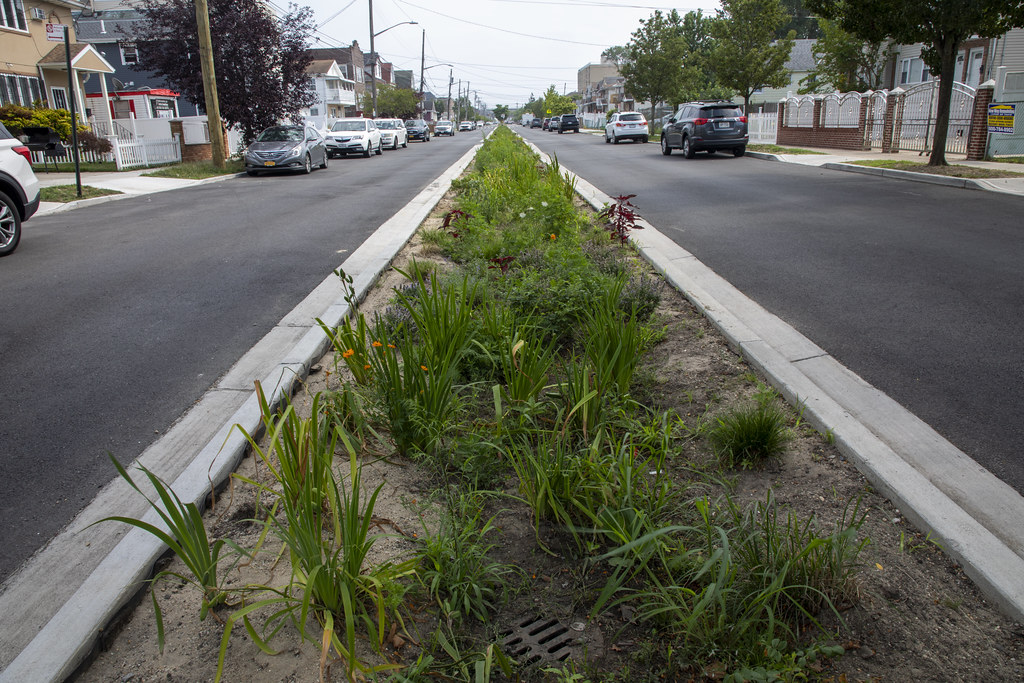Jamaica Bay Street Medians Transformed into Green Infrastructure that Absorbs Stormwater, Reduces Flooding
September 6, 2023
Project marks first time NYC has transformed large roadway medians into green infrastructure “sponges” to absorb stormwater in Arverne
Photos are available on DEP’s Flickr Page
New York City Department of Environmental Protection (DEP) Commissioner Rohit T. Aggarwala today announced the completion of construction that transformed three roadway medians into green infrastructure sponges that absorb stormwater and reduce chronic neighborhood flooding to better protect Jamaica Bay.
The new green infrastructure roadway medians feature subsurface stormwater storage and new native plants to maximize the amount of stormwater they can hold. The work took place along Beach 67th Street between Almeda and Thursby Avenues, in the Arverne neighborhood of the Rockaways, and also included pedestrian ramp improvements. The $1.2 million project was funded and managed by DEP.
“Transforming these medians into working green infrastructure that absorbs stormwater helps to reduce any flooding along Beach 67th Street while also protecting nearby Jamaica Bay,” said DEP Commissioner Rohit T. Aggarwala. “In just the last several years we have constructed more than 12,000 similar installations that absorb stormwater and beautify neighborhoods across the city. We will continue to aggressively expand this critical work that is making our city more resilient to the changing climate.”
“As the peak of hurricane season nears, these new green infrastructure sponges in Arverne are a welcome addition to the Rockaway community, which we know is extremely prone to strong storms and coastal flooding,” said Queens Borough President Donovan Richards Jr. “Every new median helps as we leave no stone unturned to mitigate flooding and protect our shoreline communities. Thank you to the NYC Department of Environmental Protection for its partnership to make Queens a more sustainable, resilient borough.”
“Resiliency is essential to the health and safety of our communities, especially on the Rockaway Peninsula” said NYC Council Majority Whip Selvena N. Brooks-Powers, Chair of the Committee on Transportation and Infrastructure. “I applaud DEP’s efforts to expand green infrastructure in our community and improve our stormwater management systems, and I look forward to further investments in the resiliency and sustainability of the Rockaway community.”
“The completion of this green infrastructure project in Arverne is a significant step in our efforts to combat increased flooding that is devastating to residents of Southeast Queens,” said State Senator James Sanders Jr. “We are in the midst of a climate emergency, and this is the type of action that is needed. Investing in green infrastructure is not just about environmental sustainability, but also about protecting our communities for generations to come.”
“I am delighted to see the realization of the Arverne Medians Green Infrastructure Project, transforming underutilized roadway medians into green infrastructure,” said Assembly Member Khaleel M. Anderson. “This innovative project is the first of its kind here in New York City, and I am proud to welcome green infrastructure here in the Arverne region of my district. As we grapple with the impacts of climate change, such as rising sea levels and flash flooding, these modifications will be vital for working-class families of color here in Assembly District 31. I strongly urge the Department of Environmental Protection to expand this innovative infrastructure project to include the Rockaway Peninsula and all communities across Southeast Queens that are vulnerable to flooding.”
Work included removing the old median curbs, trees, plantings and the accumulated trash. Stormwater storage vaults and drains were installed five feet below the surface and covered with stones and engineered soil—all elements designed to maximize the amount of stormwater that the median will be able to contain. Modeling shows that the new medians will absorb approximately 90,000 gallons of stormwater annually.
The landscape work includes the addition of native plants, shrubs, ornamental grasses and perennial wildflowers, which will also help absorb stormwater and enhance the aesthetic value of the surrounding area. To ensure that stormwater drains into the medians, the project included reconstructing the sidewalks and curbs, and resurfacing of the roadways to properly pitch them. Openings along the curb of the new medians also allow stormwater to drain into the planted areas and the subsurface detention systems.
Additional large concrete medians in Queens, including Queens Village, will be transformed into resilient green infrastructure medians, with additional sites in the planning and design stages. Over the last several years DEP’s nation-leading green infrastructure program has constructed more than 12,000 green infrastructure installations including curbside rain gardens, green roofs, subsurface detention, permeable pavers, concrete and asphalt, and now green medians have been added to the City’s stormwater management toolbox. All of these green installations intercept stormwater before it can drain into the sewer system, thereby creating additional capacity in the sewers which helps to reduce flooding and sewer overflows into local waterways.
DEP manages New York City’s water supply, providing approximately 1 billion gallons of high-quality drinking water each day to nearly 10 million residents, including 8.5 million in New York City. The water is delivered from a watershed that extends more than 125 miles from the city, comprising 19 reservoirs and three controlled lakes. Approximately 7,000 miles of water mains, tunnels and aqueducts bring water to homes and businesses throughout the five boroughs, and 7,500 miles of sewer lines and 96 pump stations take wastewater to 14 in-city treatment plants. DEP also protects the health and safety of New Yorkers by enforcing the Air and Noise Codes and asbestos rules. DEP has a robust capital program, with a planned $31.3 billion in investments over the next 10 years. For more information, visit nyc.gov/dep, like us on Facebook, or follow us on X, formerly known as Twitter.





